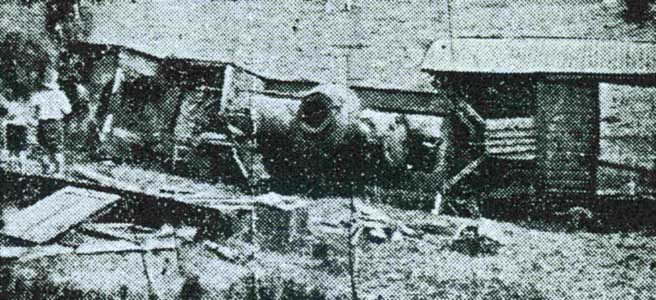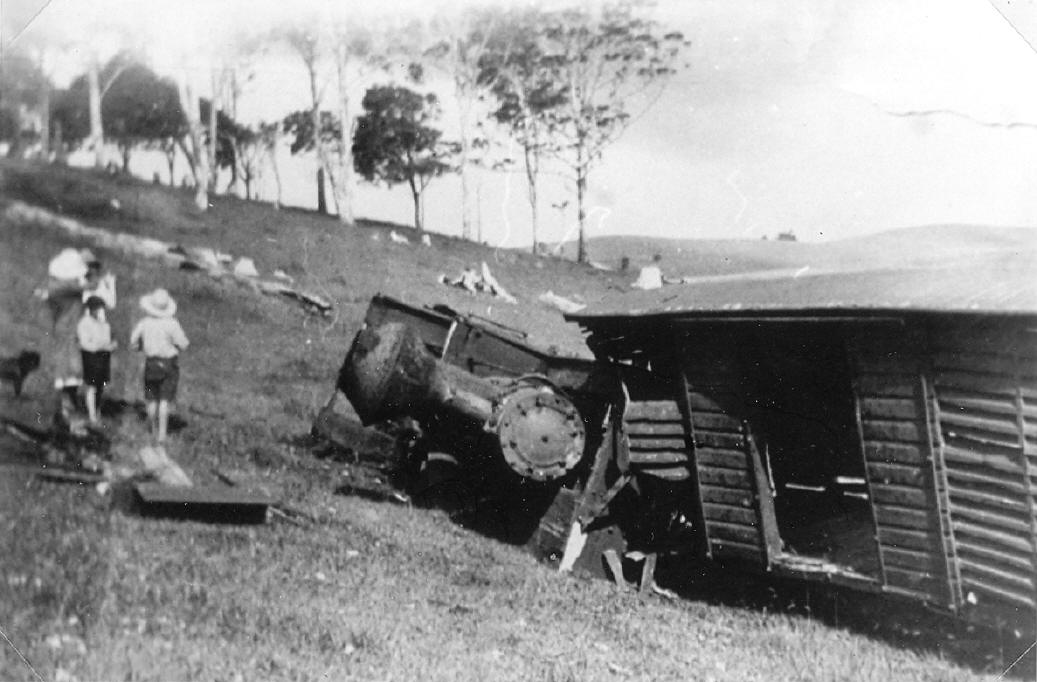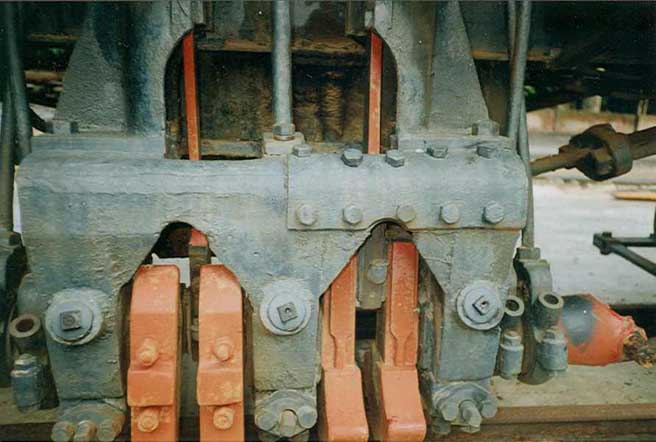Sand was dropped to assist braking, but
too much caused the sprags to break.
There were some places between the Highworth loop and the foot of the Highworth
Range where the downhill gradient eased and the driver would have to put on steam to keep
the tram moving.
This method of braking inevitably led to flat spots on the wheels of the cane trucks, but that did not induce the Mill to fit proper brakes to the trucks. In their opinion, it was cheaper to turn down or replace the damaged wheel sets, than to modify the trucks by fitting screw brakes. The Shire Council continued this policy so far as cane trucks were concerned, when they took over the Nambour to Kureelpa line. After the extension to Mapleton was completed, it was found that cane trucks also needed to be spragged when coming down from Mapleton to the South Maroochy River at Kureelpa.
The
most serious accident was a derailment at Kureelpa on 14th March 1934, that
fortunately did not cause anyone permanent injury. That Wednesday morning, the Mapleton
locomotive, running bunker first, was hauling the morning tram from Mapleton
to Nambour. The train consisted of four vehicles, the first of which was the van
loaded with cans of cream. On the downhill grade between the Kureelpa Hall and
the bottom of Doig's bank, the train picked up excessive speed as it passed
through Captain Jewett's farm.
According to the press report, the rails were greasy, the sand box pipes were clogged, and though an emergency application of the loco's steam-brake was made, the engine did not slow down. The train went out of control, and the Mapleton jumped the tracks on a curve. It travelled for a hundred yards (ninety metres) in the dirt before toppling onto its right side against a gentle grassy slope. The front of the cream van was crushed against the frame of the locomotive by the other vehicles. The Mapleton's cabside was damaged, and parts of the engine and driving gear were embedded in the earth.
The
only casualty was the driver, Bill English Snr, whose foot and ankle were badly
crushed. The fireman, Jack Moloney, used an axe to chop him free from the
splintered wooden cab of the overturned engine. On his admission to the Maroochy
District Hospital, doctors wished to amputate the foot. According to Myrtle
Simpson, daughter of guard Jock (who was off duty that day), Bill refused to let
them do this, as he fancied himself as a good dancing partner. Fortunately, the
doctors were able to save the foot, but Bill was off work for some months.
The
manager of the Shire Tramways Mr Steve J. Hobson sent a repair gang from Nambour
to the scene of the accident, and the Dulong locomotive (normally based at Nambour for hauling cane to the
Mill from Burnside and Perwillowen) was brought up that afternoon to assist in
re-railing its unfortunate sister. Neither the Mapleton nor the track was badly damaged, and normal services were
soon restored by the Dulong once the
line was cleared.
In
reporting the accident, The Nambour
Chronicle of 16th March 1934 stated that Mr English was "known as a most
capable and reliable driver", and expressed the opinion that "it is
fortunate that the accident happened where it did, as, had it happened on the
main Mapleton or Dulong Range, the consequence would have been more serious."
On a more pragmatic note, the paper reported that "only a few gallons out of
one can [of cream] were lost".
"Mapleton
Tram Derailed
Accident Near Kureelpa
Driver Admitted to Hospital
"Due to the greasy nature of the track and the failure of the sand-box to operate in the distribution of sand on the rails, the locomotive of the Mapleton tram, despite the application of the steam-brake, left the rails near Kureelpa, four miles from Nambour, on Wednesday morning, and toppled to one side against a bank. The driver, Mr William English, had his foot pinned against the side of the cabin, through his being held by the woodwork, and sustained an abraised and contused left foot with fracture of one or more bones of the instep, and suffered shock. The locomotive travelled about one hundred yards before coming to rest against a bank in a cutting.
"In order to extricate the driver, the fireman (Mr J. Moloney), with assistance, was required to chop away portion of the woodwork of the cabin. Mr English, who is known as a most capable and reliable driver, was attended by the Ambulance and conveyed for medical attention, and later was admitted to the Maroochy District Hospital.
"It is fortunate that the accident occurred where it did, as had it happened on the main Mapleton or Dulong range, the consequence would have been more serious. At the time of the accident the tram, drawing four vehicles, was descending a slight gradient, and was proceeding to Nambour working to the usual daily time-table. Cans of cream were being transported, but only a few gallons out of one can was lost. Provision was made whereby the cream was transported to Nambour to connect with first available trains for carriage to the factories.
"A second locomotive was sent to the scene of the accident on Wednesday afternoon, and work commended to haul the derailed engine on to the line. It was not then known the extent of the damage to the engine, as portion of the driving gears were embedded in the ground. As soon as the line is cleared the other spare locomotive will be put into commission. As far as could be ascertained the track was little damaged, and running, once the line was clear, would be resumed with as little delay as possible.
"The
manager of the Mapleton Tram (Mr S. J. Hobson), when the accident was referred
to him on Wednesday evening, said the steam brake was most effective, and with
its operation sand was released from the sand-box through a rubber tube on to
the rails. In wet weather the moisture often clogged the pipe and prevented a
free release of the sand."

"Driver Pinned Under Engine
"When the Mapleton Tram came off a few miles out of Nambour, the driver, W. English (38), was pinned beneath it, and had his ankle badly crushed and broken. On the trip from Mapleton to Nambour this morning, the tram ran off the rails while negotiating a sharp curve at Kureelpa, about three miles below the Mapleton Range. The engine, two cream wagons, and a passenger van overturned, and only a truck of logs remained upright. The engine was badly damaged.
"The ambulance conveyed English to the Maroochy District Hospital. There were no passengers on the tram, and the guard and fireman escaped injury. The cream cans were all capsized and the cream lost. Repairs are likely to take some days. The track was slippery, following light rain, and the tram was moving on a down grade with the morning load."

Mapleton off the road in Captain Jewett's farm at Kureelpa, 14th March, 1934
Neil
Simpson was working on the tramway in the late 1930s. His father was Jock, who had
been the guard for many years, being appointed shortly after the opening of the
extension to Mapleton in 1915. Neil was an old pupil of the Mapleton State
School. He visited the School during its centenary in 1999, and wrote the memoirs which
appeared in the centenary book, 'Top
of the Range'. Those memoirs are reproduced
here. In
November 2000 he revisited the area and retraced the route of the tram from
Nambour to Mapleton in the company of his two sons Russell and Phillip, Mr
Trevor Robinson of Palmwoods, Mr Laurie Francis of Woombye (former driver of the
'Vanguard' petrol-driven locomotive owned by the Moreton Central Mill), and
the present writer.
In
remembering this accident, Neil has stated that, in his opinion, the story given
to the press was a furphy or cover-up. As he recalled it, the steam-brake had
been applied, but failed to operate properly. This would have been caused either
by insufficient steam pressure or mechanical failure. There is a possibility
that steam pressure could have fallen drastically in the climb up Christie's bank, so that
there was not enough pressure to force the brake shoes hard enough against the
wheels as the tram descended through Captain Jewett's farm, but Neil thinks
that the actual braking mechanism was faulty.
It is
also true that in wet weather, moisture could penetrate the sand pipes which
would then become clogged with wet sand, and fail to deliver sand to the rails.
Emily English, wife of Bill Jnr, has stated that the sand boxes were found to be
empty when they were checked after the accident, and children were suspected of
tampering with them. Whatever may have been the cause of the misadventure, all
we can be sure of is that an emergency application of the brake did not prevent
it.
The Nambour Chronicle made a point of stating, "The Manager of the Mapleton Tram (Mr S. J. Hobson), when the accident was referred to him on Wednesday evening, said the steam-brake was most effective." Maybe the Manager thought that to blame greasy rails would be more acceptable to the tramway users and the Maroochy Shire Council, than to admit that on this occasion the tram had suffered from brake failure. It is easy to forget that brakes on older locos were not as effective as present-day brakes, and we can understand why drivers would pull their Johnson bar into full reverse and put on steam in attempts to stop their trains in emergencies.
The present author believes that the crankshaft casting of the locomotive was damaged, possibly cracked in this accident. To repair the damage, a section of steel plate was cut and shaped to size, and bolted over the outside of the crack with ten large bolts. Perhaps welding was not possible. Subsequent photographs of the Mapleton show this plate in position, the ten bolt heads showing clearly in two rows under the leading cylinder, just above the crankshaft itself.
